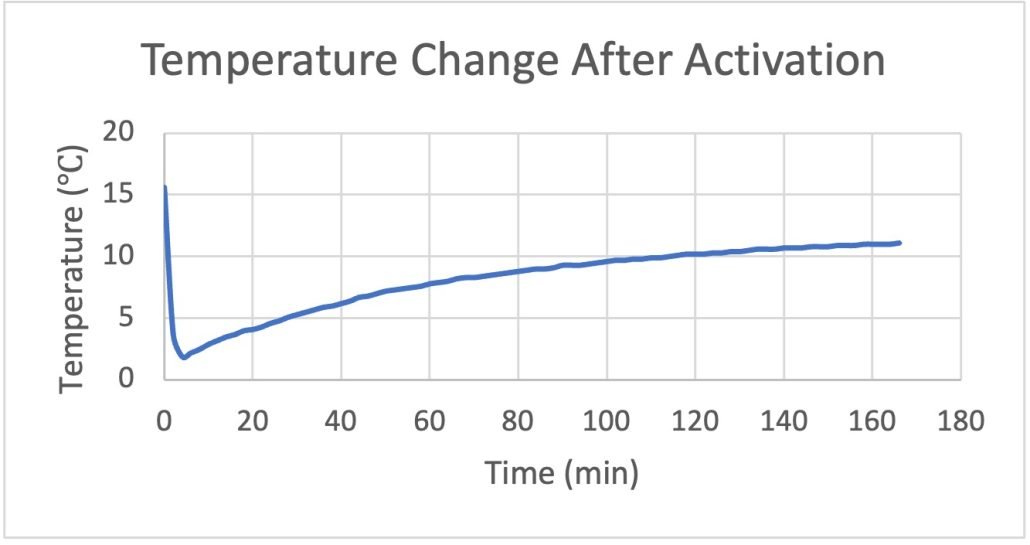Instant cold packs, also called instant ice packs, are a convenient way to provide therapeutic cold therapy. Efficient in providing immediate pain relief, they are vital in first aid kits. Their design allows instant cold application, offering immediate alleviation for sports injuries such as sprains and strains.
With instant ice packs, you don’t have to wait for the pack to freeze before using it — they’re ready to go in just seconds. But what makes this tool work the way it does? Keep reading to find out!
What is an instant cold pack made of?
The ice pack consists of two main components in equal proportions: water and a chemical compound, typically calcium ammonium nitrate (CAN) or urea.
The water and the chemical compound are not mixed from the onset. Instead, the pack employs a design that ensures each component is segregated within separate areas. The water is securely enclosed in a breakable plastic bag within the structure of the instant ice pack, while the CAN or urea is stored outside of this water bag. The photo below shows an example of the contents inside an instant ice pack.

This design allows for the active substance and water to remain separate until the time of use. But what happens when these two components are mixed? How does it provide cold to the affected area in cases of sprain injury?
How do instant ice packs work?
When using the product, locate the inner bag inside the pack and break it by squeezing or bending it, following the instructions printed on the ice pack.
Once the water bag is ruptured, the water mixes with the external component of the cold pack. Mixing two separate ingredients triggers a spontaneous physical reaction known as an endothermic reaction.
In endothermic reactions, the system absorbs heat from the surrounding environment. This reaction is what happens in an instant ice pack. When the water mixes with urea or CAN, the component dissolves, simultaneously absorbing heat from the environment, which causes a sudden drop in temperature.
The outcome of this reaction is a cold pack that rapidly reaches the desired temperature, providing a soothing relief effect. The cold pack emits an intense cold sensation by utilizing the surrounding heat to fuel the endothermic reaction. This sensation is crucial role in reducing swelling and promoting faster healing, making the instant ice pack an effective and quick solution for treating injuries.
Performance of an activated instant cold pack
To evaluate the performance of a cold pack, an experiment was conducted to measure its temperature over 3 hours.
After activation, the pack’s temperature decreases from its initial temperature of 16 degrees C to its lowest point of approximately 2 degrees C in four minutes. Afterward, the temperature gradually begins to rise. For example, within an hour, the pack’s temperature increases by 5 degrees, followed by an additional 3 degrees in the following hour.

This indicates that the instant ice pack can provide quick, long-lasting cold therapy. However, to ensure the benefits of cold treatment while minimizing potential adverse effects, it is essential to never use a cold pack for more than 20 minutes at a time. The following section will discuss additional considerations when using a cold pack.
Safety guidelines for cold pack usage
While the instant cold compress offers benefits, it is vital to know that prolonged exposure to extreme cold can have serious consequences. Therefore, there are two things to keep in mind:
First, always wrap the cold pack in a towel or cloth before applying it. Do not put it directly on the skin.
Second, limit the application of cold therapy to no more than 20 minutes at a time. Use a stopwatch to keep track of the time. Exposing the body to extreme cold for extended periods can result in frostbite and tissue damage. In rare cases, it can also lead to conditions like compartment syndrome, which causes intense muscle pain, and perniosis, which is inflammation of small blood vessels in response to cold exposure.
FAQs
What is the liquid in an instant cold pack?
The liquid inside is water. The other component is solid. After use, the solid will dissolve in the water, and the fluid will turn into a solution.
How long does it take for an instant cold pack to work?
You can feel the cooling effect almost immediately, and the cold pack can reach its lowest temperature in just 5 minutes.
Do instant cold packs require refrigeration?
No, they do not. Instant cold packs are activated by breaking the inside bag to mix the two components.
Are instant cold packs physical or chemical?
Instant cold packs involve physical reactions that absorb heat from the environment, called endothermic reactions.
How many times can you use an instant ice pack?
Only once.
How does an instant ice pack get cold so quickly?
The cold pack gets cold quickly due to the rapid dissolution of urea (or calcium ammonium nitrate) in water. This reaction occurs rapidly and absorbs significant heat from the environment.
What are the alternative cold care products and their differences?
The market offers various alternative cold care products besides instant cold packs. These options include ice bags, gel packs, and gel bead packs, each with unique features to provide effective cold therapy.

Ice Bags are a traditional, reusable solution for cold therapy. Users can fill them with either ice cubes or cold water, and they can customize the amount of coldness needed. However, their reliance on a separate ice or cold water source can limit their immediate application in certain situations.
Ice Gel Packs provide another option for cold therapy users. Pre-filled with a gel-like substance, users must store these packs in a freezer for approximately 2 hours before usage. The gel then retains the desired level of coldness, making it an excellent reusable alternative to instant cold packs. However, as with ice bags, their pre-freezing requirement makes spontaneous use more challenging.
Gel Bead Packs are similar to ice gel packs but with a slight variation. These packs contain individual gel beads that, when pre-frozen, offer a highly flexible and adaptable cold therapy option. The bead-filled structure enables the pack to contour around the target area to provide optimal relief. As with ice gel packs, a pre-freezing time of approximately 2 hours is required.
Reference
Healthwise Staff. (2023, February 26). Using ice and cold packs. Using Ice and Cold Packs | University of Michigan Health. https://www.uofmhealth.org/health-library/sig43888spec
Laura Inverarity, D. (2023, May 24). Learn how long you should be icing an injury to reduce inflammation. Verywell Health. https://www.verywellhealth.com/how-long-should-you-ice-an-injury-2696108
Mutlu, S., & Yılmaz, E. (2020). The effect of soft tissue injury cold application duration on symptoms, edema, joint mobility, and patient satisfaction: A randomized controlled trial. Journal of Emergency Nursing, 46(4), 449–459. https://doi.org/10.1016/j.jen.2020.02.017
Piana, L. E., Garvey, K. D., Burns, H., & Matzkin, E. G. (2018). The cold, hard facts of cryotherapy in orthopedics. The American Journal of Orthopedics, 47(9). https://doi.org/10.12788/ajo.2018.0075



